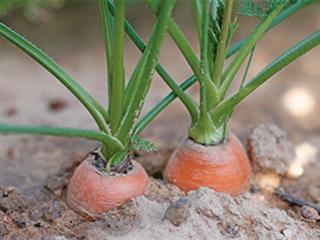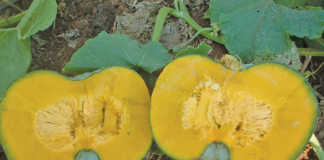
Herbicides make weed control tillage in a carrot crop unnecessary unless the soil caps after a heavy rain. With wide rows it’s a good idea to loosen heavy, compacted soil by running a tine to a depth of about 20cm between the rows, when the roots are about 15mm wide. This allows good root swell and gives smoother, better shaped roots. When the upper part of the root is exposed to light, chlorophyll forms, resulting in undesirable green shoulders. Keeping the shoulders covered with soil will prevent this.
Fertiliser
Carrots need fertile soil which allows rapid, uninterrupted growth. In many of the moister areas of KZN the soil is leached and acidic and fairly heavy fertiliser dressings may be necessary. The use of compost or organic manure isn’t recommended, as these can cause unattractive, hairy roots. You can use organic manures on other crops in the rotation.
Suitable liming and fertiliser programmes, based on reliable soil analyses, should be developed for each land. A pH of 6 to 6,5 is regarded as optimum for carrot production.

Irrigation
From planting time until the plants are well established, never allow the soil to dry out. This will ensure a good stand. The top 40mm or so of the soil, in which the seeds are planted and the early root development occurs, may dry out rapidly in hot conditions unless frequent light irrigations (only 5mm to 10mm may be necessary) are applied. Generally, 25mm of water a week should be adequate, but in warm, dry, summer conditions, especially if there are hot winds, up to 50mm may be necessary.
Rotation
A three-year rotation reduces the risk of pest and disease build-up. By including deeper-rooted crops in the rotation, nutrients and moisture from deeper soil layers can be utilised by the shallow-rooted carrot.
Harvesting
Carrots can be harvested from 12 to 16 weeks, as soon as they reach the required size. When bigger carrots are removed, other plants have more space to grow. But carrots shouldn’t be left in the soil too long as younger carrots taste better than older ones.
Marketing
After harvesting, carrots are washed and graded. Some are then marketed in bunches of five to 10 carrots with the leaves attached. The ‘quality’ of the leaves is important to buyers, as it gives an indication of the freshness of the product. However, as roots with leaves attached wilt more rapidly, carrots are usually sent to market without leaves and packed in mesh pockets.
Row planting carrots
Row planting is preferable to broadcast sowing. Rows are generally 200mm to 400mm apart but for baby carrot production, rows may be as close as 100mm. A mistake often made by new growers is to plant too densely. A first plant count per metre per row, with rows 200mm apart, shouldn’t exceed 30 to 35 uniformly spaced plants. In a smaller operation, when two to three leaves emerge, seedlings should be thinned to about 3cm apart. When the seedlings are 15cm tall, thin them out again to about 5cm to 7cm apart. The roots from the second thinning may be big enough to eat.
Source: The department of agriculture’s Directorate: Agricultural Information Services in co-operation with ARC-Roodeplaat Vegetable and Ornamental Plant Institute.













